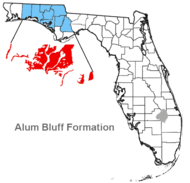Alum Bluff Formation
| Alum Bluff Group Stratigraphic range: Late Oligocene-Early Miocene | |
|---|---|
| Type | Geological formation |
| Sub-units | Chipola Formation, Oak Grove Sand, Shoal River Formation, Choctawhatchee Formation, Jackson Bluff Formation |
| Lithology | |
| Primary | Dolostone, phosphate, clay, sand |
| Location | |
| Region | Florida Panhandle |
| Country |
|
| Type section | |
| Named for | Alum Bluff on the Chipola River |
| Named by | Dall & Stanley-Brown, 1894 |

The Alum Bluff Formation is a Late Oligocene to Early Miocene geologic formation in the central Florida Panhandle. It was originally mapped by Brooks in 1982 and designated the Shoal River Formation.
Age
Period: Paleogene to Neogene
Epoch: Late Oligocene to Early Miocene
Faunal stage: Chattian through Hemphillian ~23.03—5.33 mya, calculates to a period of 17.7 million years
Location
The Alum Bluff Group replaces the Hawthorn Group west of the Apalachicola River with occurrences in Bay, Calhoun, Holmes, Jackson, Liberty, Okaloosa, Walton, and Washington counties. It is younger than the Torreya Formation to the east based on superpositioning.
The Alum Bluff Group has an outcropping beneath a thin overburden in the western panhandle from river valleys in Okloosa County eastward to western Jackson County.
Lithography
The group is composed of clays, sands and shell beds. These vary from fossil bearing sandy clays to sands, clays, and carbonate beds absent of fossil content with glauconite and phosphate mica which is common. The coloration is from cream to olive gray with mottled reddish brown in the weathered sections. The sands are soft and very fine to coarse with sporadic gravel while carbonate lenses are quite hard. Permeability of the sediments are generally low and are part of the intermediate confining unit/aquifer system.[1][2]
Members
The Alum Bluff Group are defined by the stratigraphic position and mollusks contained within. The group includes:
- Chipola Formation
- Oak Grove Sand
- Shoal River Formation
- Choctawhatchee Formation
- Jackson Bluff Formation
The Alum Bluff Group has a residuum on Miocene sediments and undifferentiated sediment of the Miocene. This consists of reddish brown, variably sandy clay with inclusions of variably fossiliferous, silicified limestone. The residuum includes Lower to Upper Miocene and younger weathered sediments.[3]
Fossils
- Mollusks both herbivorous and carnivorous in equal percentages.[4]
- Filter feeders at ~7%
References
- ↑ United States Geological Survey: Lithostratigraphic Units
- ↑ Matson, George Charles, The phosphate deposits of Florida, Bulletin - United States Geological Survey, 1915
- ↑ United States Geological Survey: Alum Bluff Group
- ↑ Kline, H., Herbert, G., Harries, P., Oches, E., CHES, E., and Portell, R., Trophic Structure OF Shell Beds from the Early Miocene Chipola Formations of Florida
- Finch, J., Geological essay on the Tertiary formation in America: American Journal of Science, v. 7, p. 31-43, 1823.
Further reading
- Berkenkotter, Richard D, Application of statistical analysis in evaluating bedded deposits of variable thickness—Florida phosphate data (United States. Bureau of Mines. Report of investigations, U.S. Dept. of the Interior, Bureau of Mines (1964)